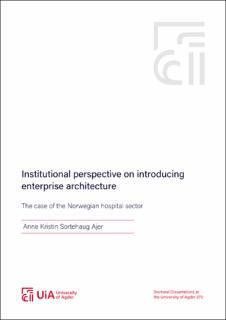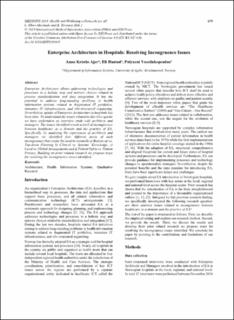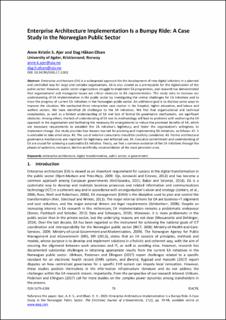| dc.contributor.advisor | Hustad, Eli | |
| dc.contributor.advisor | Vassilakopoulou, Polyxeni | |
| dc.contributor.author | Ajer, Anne Kristin Sortehaug | |
| dc.date.accessioned | 2020-05-27T22:37:01Z | |
| dc.date.available | 2020-05-27T22:37:01Z | |
| dc.date.created | 2020-05-25T14:18:47Z | |
| dc.date.issued | 2020 | |
| dc.identifier.citation | Ajer, A. K. S. (2020). Institutional perspective on introducing enterprise architecture: The case of the Norwegian hospital sector (Doctoral thesis). University of Agder, Kristiansand. | en_US |
| dc.identifier.isbn | 978-82-7117-973-1 | |
| dc.identifier.issn | 1504-9272 | |
| dc.identifier.uri | https://hdl.handle.net/11250/2655839 | |
| dc.description | Paper I, II, and III are not available as a part of the dissertation due to the copyright. | en_US |
| dc.description.abstract | The findings from this thesis point to the incongruence between the characteristics of EA and the healthcare domain as specific tensions among the EA logic and different professional logics as a source of deviation. The incongruence comes from the long-term plan-driven EA approach versus healthcare traditions and needs for ad-hoc initiatives. Other themes stem from the EA logic of process standardisation, which poses challenges in gaining acceptance and trust that the processes dinscribe appropriate clinical knowledge and provide support for local variations. Moreover, the EA vision of data integration across organisational units and across IS has implications for concerns about privacy and protection of sensitive data, but this can collide with the healthcare view on patient safety and the need for mission-critical data.
This dissertation makes several contributions to research and practice. First, it augments the EA research stream by offering rich insights and specific implications related to challenges of EA institutionalisation in healthcare. A description of the enterprise architects’ logics and the EA logic supplements the EA knowledge base. Likewise, it presents a model of a predicted evolution of the EA initiatives through the phases of optimism, resistance, decline and finally, reconsolidation of the most persistent ones, unless firm mandates are established from the start. Furthermore, the study provides a model that illustrates how coexisting institutional logics maintain their distinct character while allowing compromises that shape EA operationalisation. The model shows a set of scenarios for settling tensions in project decisions. In these scenarios, EA is foregrounded, blended with other available institutional logics or suppressed.
Second, this dissertation contributes to an enhanced theoretical and empirical understanding of EA institutionalisation, where regulative, normative and culturalcognitive elements create and maintain EA as an institution, and unsurprisingly, the organisational response impedes the institutionalisation process. The organisational response can be explained by selective activated institutional logics among the actors. However, with targeted institutional work from the actors that want EA to be institutionalised, the process can be reinforced.
This thesis also offers some practical suggestions at the national policy level. First, financial arrangements should be assessed to encourage broader involvement from the sub-organisations. Second, through active ownership, they can address the need for enhanced EA understanding and should secure the education of the actors, not the least at the executive level, together with the targeted hires. Furthermore, the need for organisational changes related to EA is under-communicated. The thesis also makes practical suggestions to deal with the challenges, the incongruence and the consequent tensions, mainly by finding solutions that balance between the institutional logics of EA and of healthcare. | en_US |
| dc.language.iso | eng | en_US |
| dc.publisher | 07 Media | en_US |
| dc.relation.ispartofseries | Doctoral dissertations at the University of Agder; no. 272 | |
| dc.relation.haspart | Paper I: Ajer, A. K. S. (2018). Enterprise architecture in healthcare and underlying institutional logics: A systematic literature review of IS research. In M. Tanabu & D. Senoo (Eds.), Pacis 2018 Proceedings - Opportunities and Challenges for the Digitized Society: Are We Ready?. https://aisel.aisnet.org/pacis2018/280. Published version. Full-text is not available in AURA as a separate file. | en_US |
| dc.relation.haspart | Paper II: Ajer, A. K. S. & Olsen, D. H. (2018). Enterprise Architecture Challenges: A Case Study of three Norwegian Public Sectors. In P. Bednar, U. Frank & K. Kautz (Eds.), European Conference on Information Systems: Beyond Digitization - Facets of Socio-Technical Change. https://aisel.aisnet.org/ecis2018_rp/51. Published version. Full-text is not available in AURA as a separate file. | en_US |
| dc.relation.haspart | Paper III: Ajer, A. K. S., Hustad, E. & Vassilakopoulou, P. (2018). Enterprise Architects’ Logics across Organizational Levels: A Case Study in the Norwegian Hospital Sector. In P. Kourouthanassis, P. Markopoulos, A. Pateli, N. Pouloudi, A. Pucihar & J. Vieira da Cunha (Eds.), Proceedings of the Twelfth Mediterranean Conference on Information Systems - Digital and social transformation for a better society. https://aisel.aisnet.org/mcis2018/6. Published version. Full-text is not available in AURA as a separate file. | en_US |
| dc.relation.haspart | Paper IV: Ajer, A. K. S., Hustad, E. & Vassilakopoulou, P. (2019). Enterprise Architecture in Hospitals: Resolving Incongruence Issues. In L. Ohno-Machado & B. Seroussi (Eds.), Health and Wellbeing e-Networks for All - Proceedings of the 17th World Congress on Medical and Health Informatics (264, p. 659-663). doi: http://dx.doi.org/10.3233/SHTI190305. Published version. Full-text is available in AURA as a separate file: https://hdl.handle.net/11250/2649329. | en_US |
| dc.relation.haspart | Paper V: Ajer, A. K. S. & Olsen, D. H. (2020). Enterprise Architecture Implementation Is a Bumpy Ride: A Case Study in the Norwegian Public Sector. Electronic Journal of e-Government, 17(2), 79-94. doi: http://dx.doi.org/10.34190/EJEG.17.2.002. Author´s accepted manuscript. Full-text is available in AURA as a separate file: . | en_US |
| dc.relation.haspart | Paper VI: Ajer, A. K. S. (Forthcoming). Enterprise Architecture and Institutional Pluralism: the case of the Norwegian hospital sector. Author´s submitted manuscript. Full-text is not available in AURA as a separate file. | en_US |
| dc.title | Institutional perspective on introducing enterprise architecture : The case of the Norwegian hospital sector | en_US |
| dc.type | Doctoral thesis | en_US |
| dc.description.version | publishedVersion | en_US |
| dc.rights.holder | © 2020 Anne Kristin Sortehaug Ajer | en_US |
| dc.source.pagenumber | 277 | en_US |
| dc.source.issue | 272 | en_US |
| dc.identifier.cristin | 1812462 | |


